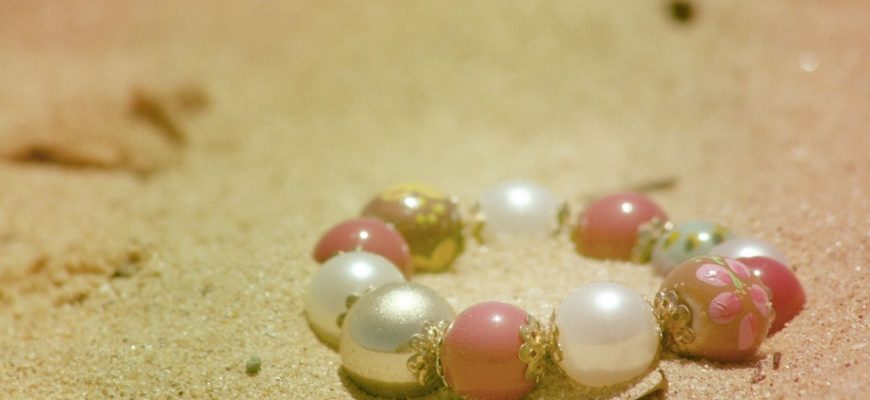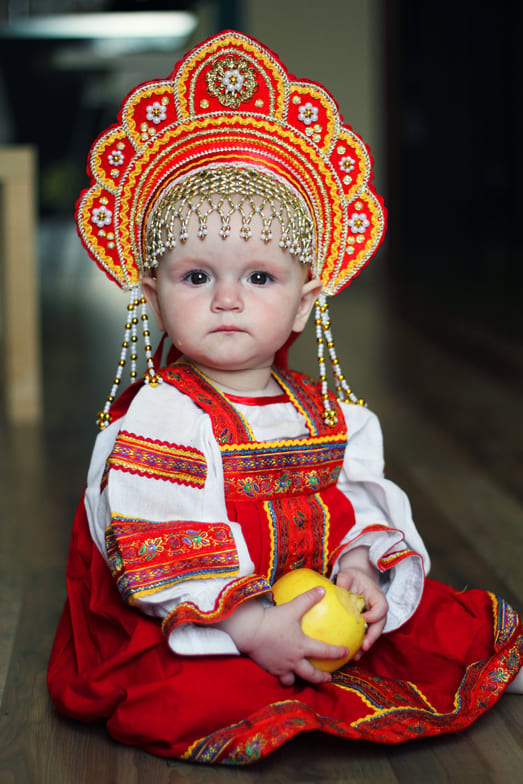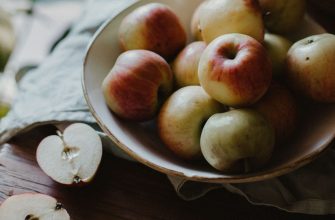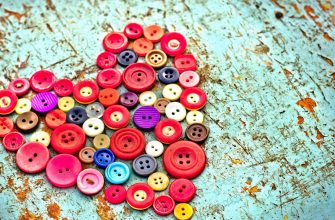Национальный русский костюм (National Russian costume)
Traditional clothes express the people’s identity through the national costumes. They often look nice and colourful. As a rule, they show the wearer’s role in society, his rank or social status as well as his marital status and age. National costumes also have to protect the wearer from cold or bad weather.
Probably the best-known traditional pieces of clothing in Russia are sarafans and rubakhas. The sarafan was the main part of the female wardrobe. It’s a long sleeveless dress which was often worn on top of a rubakha. The rubakha was a linen oversize shirt or blouse. Russian people hand-painted linen fabric, sewed shirts and sarafans and decorated them with embroidery.
Traditional man’s outfit consisted of a rubakha, long narrow trousers, leather boots, a kushak (a waistband), a woolen hat and a kaftan (a light woolen coat). In summer people in Russian villages wore lapti (shoes woven from bast fiber). Traditional winter footwear was valenki (felt boots).
Russian women in the past wore sarafans, aprons, blouses, leather shoes or valenki, kokoshniks and jewellery. The kokoshnik is an amazing national women’s headwear, usually decorated with river pearls, decorative stones, golden and silver needlework.
Traditionally, Russian clothing had two main colors: white and red. Festive clothing was richly decorated with ornaments and embroidery. There were differences between the clothing of young women, married women and older women. Clothing of older women had fewer ornaments and was made in darker tones.
Традиционная одежда выражает идентичность народа при помощи национальных костюмов. Они часто выглядят очень красиво и красочно. Как правило, они демонстрируют роль их владельца в обществе, его положение или социальный статус, а также семейное положение и возраст. Национальные костюмы также должны защищать их хозяина от холодной непогоды.
Возможно, наиболее известными традиционными предметами одежды в России являются сарафаны и рубахи. Сарафан был основной частью женского гардероба. Это длинное платье без рукавов, часто надеваемое поверх рубахи. Рубахой считалась льняная рубашка или блуза большого размера. Русский народ вручную красил льняную ткань, шил рубашки и сарафаны и украшал их вышивкой.
Традиционный мужской наряд состоял из рубахи, длинных узких брюк, кожаных сапог, кушака (пояса), шерстяной шляпы и кафтана (легкого шерстяного пальто). Летом люди в русских деревнях носили лапти (обувь, плетеную из лыка). Традиционной зимней обувью были валенки (войлочные сапоги).
Русские женщины в прошлом носили сарафаны, фартуки, блузы, кожаные туфли или валенки, кокошники и украшения. Кокошник – это удивительный национальный женский головной убор, обычно декорированный речным жемчугом, камнями, золотой и серебряной вышивкой.
Традиционно, в русской одежде преобладали два основных цвета: белый и красный. Праздничная одежда была богато украшена узорами и вышивкой. Существовали различия между нарядами молодой девушки, замужней женщины и женщины престарелого возраста. На одежде пожилых женщин было меньше узоров, и шили ее из ткани более темных оттенков.
Презентация по английскому языку на тему: «Национальный русский костюм».
специалист в области арт-терапии
Описание презентации по отдельным слайдам:
Russian national costume
Russian national costume female Russian national costume women..
Sundress is one of the main parts of the Russian female national costume. Smart option to wear complete with shirt, apron. In each locality had its own style of dress, and patterns on it as on other types of Russian folk costume has its own characteristics. Сарафан – одна из главных деталей народного русского женского костюма. Нарядный вариант его носили в комплекте с рубахой и передником. В каждой местности был свой фасон сарафана, и узоры на нем, как и на других вариантах русских народных костюмов, имеет свои особенности.
The most common headdress was the kokoshnik – tight lids various shapes, and usually richly decorated with embroidery and stones Наиболее распространенным головным убором был кокошник – плотная шапочка различных форм, и обычно богато украшенная вышивкой и камнями
Russian national costume man
The basis of the male garment was the chemise or shirt bottom. Shirts were made of linen and cotton, and silk. The sleeves have a narrow brush.In step diamond-shaped gusset. In the upper part is transmitted to the belt, cord or rope for tying. Основой мужской одежды была сорочка или нижняя рубаха. Рубашки шились из льна и хлопка, и шелка. Рукава внизу сужались.Штаны заправлялись в сапоги или онучи.В шагу ромбовидная ластовица. В верхней части передается на ремень, шнур или веревка для подвязывания.
National men’s shoes Russian men Национальная мужская обувь российских мужчин
thank you for your attention
Номер материала: ДБ-210150
Не нашли то что искали?
Вам будут интересны эти курсы:
Оставьте свой комментарий
Минпросвещения готово рассмотреть альтернативы ЕГЭ
Время чтения: 1 минута
Рособрнадзор: почти половина учителей не дотягивает до базового уровня подготовки
Время чтения: 2 минуты
16 российских вузов впервые попали в международный рейтинг QS
Время чтения: 2 минуты
Итальянский учитель дал детям задание на лето и прославился
Время чтения: 4 минуты
Специалисты МГППУ запустили проект модернизации методической подготовки педагогов
Время чтения: 3 минуты
Нобелевский лауреат будет работать в Тимирязевской академии
Время чтения: 2 минуты
Подарочные сертификаты
Ответственность за разрешение любых спорных моментов, касающихся самих материалов и их содержания, берут на себя пользователи, разместившие материал на сайте. Однако администрация сайта готова оказать всяческую поддержку в решении любых вопросов, связанных с работой и содержанием сайта. Если Вы заметили, что на данном сайте незаконно используются материалы, сообщите об этом администрации сайта через форму обратной связи.
Все материалы, размещенные на сайте, созданы авторами сайта либо размещены пользователями сайта и представлены на сайте исключительно для ознакомления. Авторские права на материалы принадлежат их законным авторам. Частичное или полное копирование материалов сайта без письменного разрешения администрации сайта запрещено! Мнение администрации может не совпадать с точкой зрения авторов.
Traditional Russian clothing
Original Russian clothing.
Traditional Russian clothing is different from clothing of other countries of the world and even from the neighboring countries. Traditions have been preserved primarily within the peasantry.
During the reign of Peter I, the Russian tsar issued a decree that prohibited wearingtraditional Russian clothing in favor of foreign clothes. It was the outward manifestation of all the innovations introduced by Peter I.
Peasants were not affected by this decree. Peasants are real conservatives who rarely made any changes in their clothing. Clothing traditions in Russia among the peasants were handed down from generation to generation. And clothing was made mostly at home by using various home-produced materials.
Besides peasants, clothing traditions were preserved by the Cossacks, freeholders, Old Believers and other strata of Russian society.
Russia is a big country with diverse climate zones: from subtropical to arctic. In every region of vast Russia different styles of clothing emerged.
Traditional conservative way of life of Russian peasants
Unchanging way of life of the peasantry, restraint and adherence to traditions affected a typical female costume. Traditional Russian women’s clothing almost completely hid the female figure and focused on the face with the help of a headdress that completely hid the hair. At the same time, men’s clothing was extremely simple and almost the same throughout Russia.
A peasant girl with a calf (1820s) / Alexey Venetsianov
Color schemes in clothing
Traditionally, Russian clothing has two main colors – a natural color of the material – white, and red. “Red” is the same word that was used in the olden days to call everything beautiful. That is, red elements in clothing became beautiful elements. Interaction with other nations led to emergence of very interesting new colors in Russian clothing: yellow, gold, blue, etc.
A woman with a boy at the well (the first half of the 19 th century) / Unknown Artist
Patterns and embroideries used in decorating clothes
For the southern regions of Russia plant and geometric patterns were common, while for the Russian North – geometric patterns, zoological patterns and those associated with human life: the figures of peacocks, leopards, horses; the tree of life, crosses, complex diamond shapes and so on.
Belt is a mandatory part of traditional Russian clothing for both men and women. Belt was considered to have protective powers, acted as an amulet. Girls wore on their beltspocket-“lakomki”, and women wore on their belts purses for money and little things. Women tied their belts under their chest or under the belly. Men wore on their belts (homespun or leather) smoking accessories.
Outerwear for the transition period (spring and autumn)
Surprisingly, outerwear was the same for both men and women. Those were caftans, homespun coats,peasant overcoats and so on. The main similarity in clothing was a deep fold on the left side.
Winter clothing
Winter clothing for men and women was also similar. Those were sheepskin coats, hareskin coats, half-length fur coats – all with the fur on the inside.
Festive clothing (beginning of the 20 th century) / Northern Russia, Tver Province / Photo from the collection of Natalia Shabelskaya
On the outsidewinter clothes were also decorated.
Clothing was cinched at the waist with belts – sashes.
The Industrial revolution
Development of the industry and reduced prices of fabrics and garments, urban development had an impact on the traditional Russian clothing. Gradually among conservative peasants such women’s clothing items as “skirt-blouse” and even a dressbegan to appear.
Such changes occurred faster in the central regions of Russia, near big cities, slower – in remote villages.
1 Comment
Actually I am interested to see a typical woman dress from women from a remote village called Jazator in Russia.
Will you be able to help with this project?
Most Sincerely
Z. Cekalovic
The Netherlands
Презентация по английскому языку на тему «Традиционный русский костюм»
специалист в области арт-терапии
Описание презентации по отдельным слайдам:
Russian traditional costumes By Olga Grigor’eva, Tri Klyucha Secondary School, Bashkortostan, Russia
The Russian women’s costume was based on the “rubakha” (a linen shirt or blouse). It was made flaxen embroidery, silk lace, golden threads and spangles. Collars and sleeves were decorated extensively.
By the early 20th century the most widespread women costumes were of two types: the South Russian one with poneva, i.e. a homespun woollen skirt, and the Mid-Russian one with a sarafan, i.e. a kind of sleeveless dress.
The typical color of the sarafan and skirts was red, as this color literally translates to “beautiful”.
One of the most common type of festive head-dress was the «kokoshnik», it was masterfully decorated with river pearls, meshwork of pearls, golden and silver needlework, coloured foil and decorative stones. The head-dress was treasured in the family and handed down, and was an integral element of a well-off bride’s dowry.
Презентация «Традиционный русский костюм» на английском языке может быть использована при изучении тем «Одежда», «Традиционная одежда на Британских островах» и др. Слайды содержат описание и изображения летнего и зимнего вариантов русского традиционного женского и мужского костюмов, обуви и украшений.
Номер материала: ДБ-366933
Не нашли то что искали?
Вам будут интересны эти курсы:
Оставьте свой комментарий
Рособрнадзор: почти половина учителей не дотягивает до базового уровня подготовки
Время чтения: 2 минуты
Минпросвещения готово рассмотреть альтернативы ЕГЭ
Время чтения: 1 минута
16 российских вузов впервые попали в международный рейтинг QS
Время чтения: 2 минуты
В рейтинг лучших вузов мира Quacquarelli Symonds вошли 48 российских университетов
Время чтения: 1 минута
Итальянский учитель дал детям задание на лето и прославился
Время чтения: 4 минуты
В Петербурге начали штрафовать выпускников за шпаргалки
Время чтения: 1 минута
Подарочные сертификаты
Ответственность за разрешение любых спорных моментов, касающихся самих материалов и их содержания, берут на себя пользователи, разместившие материал на сайте. Однако администрация сайта готова оказать всяческую поддержку в решении любых вопросов, связанных с работой и содержанием сайта. Если Вы заметили, что на данном сайте незаконно используются материалы, сообщите об этом администрации сайта через форму обратной связи.
Все материалы, размещенные на сайте, созданы авторами сайта либо размещены пользователями сайта и представлены на сайте исключительно для ознакомления. Авторские права на материалы принадлежат их законным авторам. Частичное или полное копирование материалов сайта без письменного разрешения администрации сайта запрещено! Мнение администрации может не совпадать с точкой зрения авторов.
Презентация на тему: Russian national costume
Russian national costumeNatalya Akatovaschool #1694Moscow, Russia2008\2009 school yearteacher: Elena Makhovikova “Portrait of Unknown Peasant Woman in Russian National Costume” by I. Argunov (1784)
Items of clothes1. Kokoshnik2. Kosovorotka3. Perednik4. Sarafan5. Kaftan6. Tulup (or polushubok)7. Poneva8. Porti9. Onuchi 10. Lapti 11. Valenki
Kosovorotka (or Rubakha) Kosovorotka is a type of peasants’ shirt with long sleeves. Kosovorotka could be worn every day and on special occasions. Men’s shirts were to their knees and women’s ones were to their ankles. Kosovorotka was worn many centuries. It was made of white, blue and red cloth and decorated with contrast elements.
Perednik Perednik (apron) served to keep the clothes (especially dresses) clean and protect them from dirt. It was worn by peasants. Women used it in the kitchen or in the garden. When they worked outside they wore aprons made of coarse fabric. Not only women wore peredniks. It was used by men too. For example blacksmiths wore leather peredniks. On holidays it was a decoration with patterns typical for the region.
Sarafan Sarafan (pinafore) was worn by girls and young women. It is a long sleeveless dress covering feet and having the form of a high skirt with straps buttoning in front. It was worn in 14th-18th centuries. Sarafan was typical for Russian north, especially Archangelsk and Vologda province. Peasant women wore sarafans during the workdays and on holidays. In the end of 18th century it became very popular all over the country. It could be lilac, cherry blossom, raspberry pink, blue and yellow and was made of taffeta. Petty bourgeois and merchant women wore sarafans too.
Tulup (or Polushubok) Tulup or polushubok was one of the most important items of clothes in Russia. In winter both men and women wore sheepskin overcoats usually with fur on the inside. It could be also made of hare fur. Rich people wore a long fur coat named “shuba” made of sable, fox or beaver fur. People put on fur coats not just in winter but in hot summer days as well to show how rich they were.
Kaftan The word “kaftan” came from Arabic language and meant “man’s dress” It was worn in the medieval Rus. A typical kaftan was with long sleeves. In winter people put on kaftans with very long sleeves instead of gloves. There were different types of kaftans for different occasions. For example: home, rain, riding, festive kaftans and others. They were made of velvet, taffeta, satin, etc. Festive kaftans were made of expensive fabric and decorated with gold and silver buttons, pearls and jewel stones.
Poneva Poneva is a woolen three-piece skirt, made of home-made cloth, usually checkered or stripped. It was ornamented with embroidery, lace, spangles and beads. Poneva was as typical item of Russian women’s costume as sarafan. Fragments of it were found in Slavic barrows of 10-13th centuries. It was worn by married women. There were different patterns and design depending on the region.
Porti Porti are men’s trousers made of rough linen. They were long, not wide, narrowed down to ankle. They were fixed with a string tied around waist. Rich people wore woollen and even silk porti. They tucked their porti into their boots. Peasants wrapped their porti with onuchi and put on lapti over them.
Lapti (bastshoes) Lapti are bast shoes which were worn over homespun onuchi (narrow strips of cotton). They were spread in Rus in old times. Lapti were used in the countryside up to 1930s. They were made of lime-tree, elm, or birch bast. Lapti were tied to legs with cords twisted from the same bast. They were not made in all regions but they were worn everywhere. Lapti were a type of “currency” and an item of trade.
Onuchi Onuchi are long narrow strips of cloth up to 2 meters in lengths over which lapti were worn. They were different colours: white, black or brown. Peasant wore them. Onuchi became a prototype of modern socks. They wrapped feet and shins. In summer people wore onuchi made of linen or hemp cloth. In winter they were woolen ones.
Valenki Valenki are traditional Russian winter footwear. In Russian language the word “valenki” means made by felting. Valenki can be white, black or grey. They are made of sheep wool and are worn on frosty days for walking on dry snow. There is some evidence that Russian people began to make valenki in Nizhegorodskaya province in the end of 18th century. Perhaps they became “grandchildren” of Asian nomads’ felt boots. Valenki are still worn in Russian villages.





















